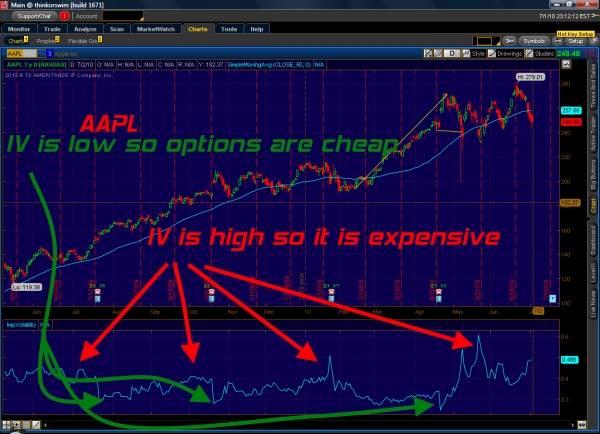Why Volcone3.0 is Worthless
admin on 07 1, 2010
I just sat through the webinar for the Volcone 3.0 and I have to say that Options University is up to its old tricks. They have produced another version of software that looks better then the last version but does the exact same thing. They have created this product to play off of the newbie trader and they should be ashamed of themselves. I will give you the quick lesson on why their product is worthless.
First we need to understand the two types of volatility: statistical stock volatility and implied volatility. Stock volatility is simply the standard deviation away from a mean. Simple statistics that we all learned. Basically it is how much the stock moves around an average. So the more it moves away from an average the higher the implied volatility. Or the more it moves in extremes around that average the higher the statistical volatility. The less the stock moves the less the stat. vol. So because we are talking about a stock and that trades with the market there are external pressures that weigh on the stock. We will talk more on this in a minute, but this is why when the market moves up, most stocks move up.
Now for implied volatility and I will try to keep it simple. This is the number that is extracted from the pricing model to tell how cheap or expensive the options are in relation to the stock price and strike price. Options fluctuate in value based on varying factors. These factors combined make up the extrinsic value. Unexplained extrinsic value is the implied volatility assumption in the option pricing model. Options expire at a specified date so they are a decaying asset. This affects the implied volatility as well. The long and the short of this is that the implied volatility is it’s own animal that feeds off of the market. As people become afraid they are willing to pay more for options. When they become comfortable they tend to be sellers of options and push prices down. When the market crashed last year implied volatility spiked to close to 100 in the S&P options based off of the fear factor and people willing to spend extra money on buying puts. Since then we have seen the IV go down to around 16 in the S&P options. So the thing that you have to understand here is that implied volatility is driven by more factors then just the stock price, there are all types of corporate or market events that drive IVs higher. Once the event is over or the unknown becomes known then the “fear” is gone and that IV will once revert to the IV mean.
Legislation in the financial sector has kept banks stock implied volatilities slightly higher than normal. So the key to understand here is that the IV will often move independently of the stock price. As I mentioned earlier the market also weighs in on the options implied vols. When BP started having issues, the rest of the industry felt their pain. BP’s IV spiked and so did the rest of their peers.
So why is the Volcone3.0 Worthless? Options University is trying to push the stocks volatility off as a measure of the IVs cheapness or expensiveness. This is just a blatant misrepresentation of the way they are marketing the tool. To truly tell if an option is cheap or expensive you need to compare the option’s IV to itself or some IV index of that stocks options that allows you to compare over time. The easiest way is to look at your brokerage platform charting package and look for the implied volatility indicator to draw on the chart. This will show you an average implied volatility over time compared to the stock price movement. You can get this for free from most brokers. In fact I grabbed a snapshot from Thinkorswim to show you in the chart below. The implied volatility is at the bottom of the chart.
When the IV is near its lows then it is relatively cheap. It will only go to zero at expiration. When the IV is spiking or near the highs then it is expensive. Depending on your strategy this is usually the time to sell or at least protect yourself against volatility risk.
Comparing stocks vols with its IV is important to see the relationship. The implied vols usually trades at a premium to the historical. There will be occurrences like stock gaps that will cause a spike in statistical vols or a takeover/merger can cause the options to go very dormant because it will be locked into a specific price so that options volatility will go very low.
There are also times when you want to use the statistical volatility to compare with the options volatility especially if you are gamma trading or doing arbitrage, but Options University fails to mention these as they are trying to get one over on newbies.
I think it is tasteless that a company with such self proclaimed experts are peddling such an inferior product. They stopped using this technique once they could track implied volatilities with computers.
In the end you will have to make your own call on this product, but I hope I have shed some light on this concept.
Popular Posts
Recent Posts
Recent Comments
- CheapIV.com » Why You can Throw Traditional Diversification in the Trash: ... have spent their
- Tim Geithner – China’s Laughing Boy - Trade the E-minis: ... Learn how Timmy
- Tim Geithner – China’s Laughing Boy | Notes from the E-mini Trading Professor: ... Learn how Timmy
- Swing Trading Stock: ... Learn Timmy Next
- Timmy Geithner has Cried “Wolf” Too Many Times | THE ART OF EXCESS: ... Learn how Timmy

